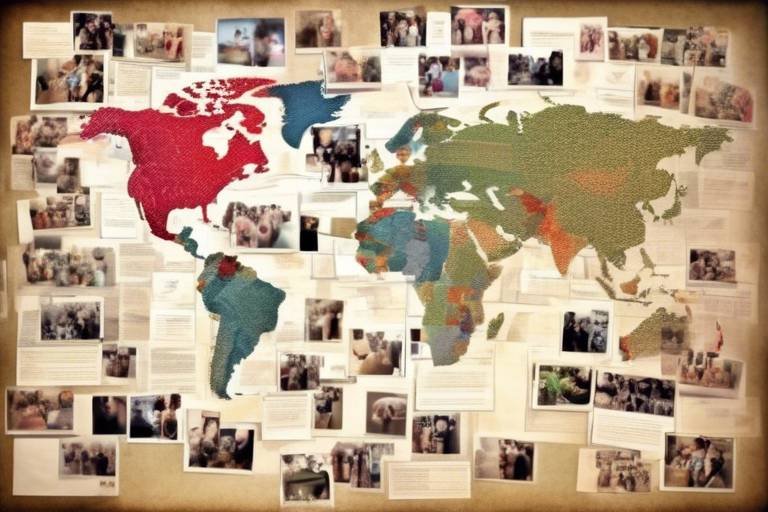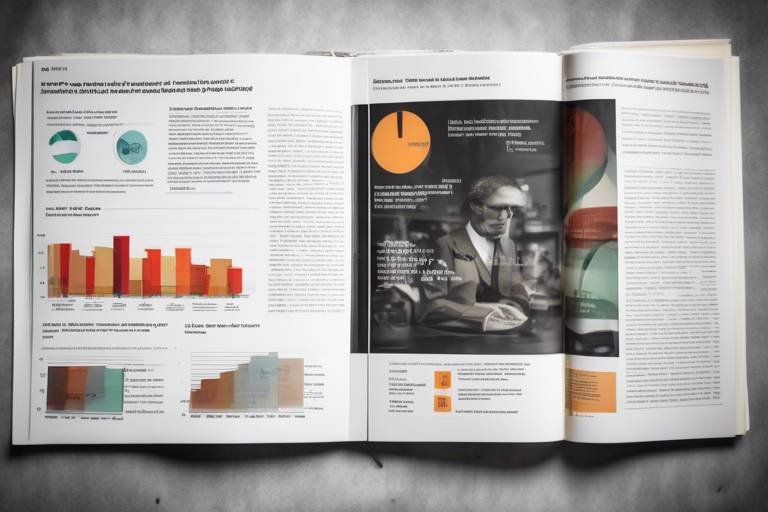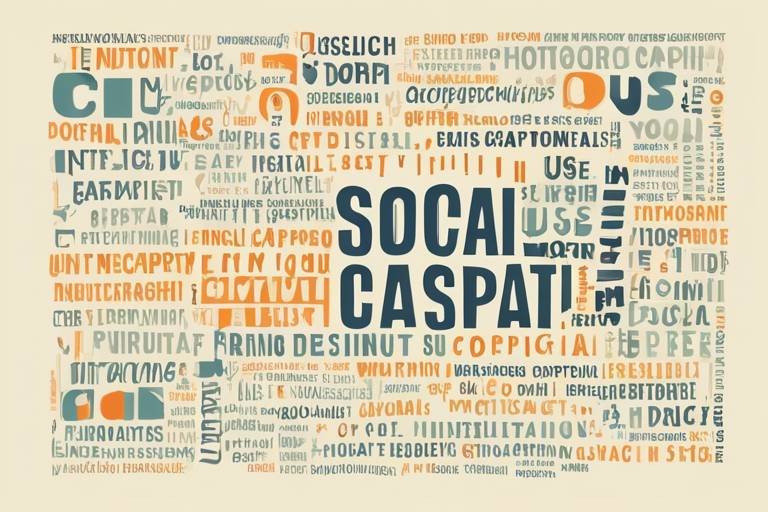How to Use Social Mapping in Participatory Research
Social mapping is like a treasure map for communities; it reveals the hidden connections and relationships that shape social dynamics. By visually representing these elements, social mapping becomes an invaluable tool in participatory research, allowing researchers and community members to collaborate effectively. In this article, we will explore the significance of social mapping, its methodologies, and how it can be applied across various fields to enhance community engagement and improve data collection.
At its core, social mapping is a visual representation that illustrates the social relationships and networks within a community. Think of it as a spider web, where each thread represents a connection between individuals, groups, or organizations. The purpose of social mapping is to facilitate a deeper understanding of social dynamics, which can lead to more informed decision-making and community development. By mapping out these relationships, researchers can identify key stakeholders, resources, and potential areas for intervention, making it a powerful tool for participatory research.
Participatory research is all about empowering communities. When researchers involve community members in the research process, they not only gain valuable insights but also foster a sense of ownership and responsibility among participants. This collaborative approach can lead to more relevant and impactful outcomes. Imagine a community coming together to address a common issue; the results are often far more effective than if a researcher were to impose solutions from the outside. The significance of participation in research cannot be overstated, as it directly influences the success of community development initiatives.
Involving community members in research brings a plethora of benefits, including:
- Increased Trust: When community members are engaged, trust builds between them and the researchers, paving the way for open communication.
- Better Data Accuracy: Community insights often reveal nuances that researchers might overlook, leading to more accurate data collection.
- Enhanced Ownership: Participants feel a sense of pride and responsibility for the research outcomes, which can drive further community action.
Effective participatory research is like planting seeds of trust. When researchers and community members work closely together, they cultivate relationships that are essential for successful outcomes. Trust is the foundation upon which collaboration is built, and without it, research efforts can falter. By engaging with the community, researchers demonstrate respect and recognition of local knowledge, which fosters a more conducive environment for sharing and learning.
Participatory methods often yield more accurate data, as community members provide insights that researchers might overlook. For instance, when mapping social networks, local residents can identify influential figures and hidden connections that are not immediately apparent. This grassroots knowledge is invaluable and can significantly enhance the quality of the data collected, leading to more effective interventions and solutions.
Despite its numerous benefits, participatory research is not without challenges. Issues such as power dynamics and resource constraints can hinder the process. For example, dominant voices in the community may overshadow others, leading to biased data. Additionally, limited resources can restrict the scope of research activities. However, recognizing these challenges allows researchers to devise strategies to mitigate them, ensuring a more inclusive and effective participatory process.
There are various methods for conducting social mapping, each with its own set of advantages and disadvantages. Traditional mapping techniques often involve manual processes, such as drawing maps during community meetings. While these methods can be effective in fostering discussion and engagement, they may also be time-consuming and less precise.
Traditional mapping techniques are akin to crafting a hand-drawn illustration of a community's social landscape. During community meetings, participants can collaboratively draw maps that represent relationships, resources, and challenges. While this method encourages active participation, it may lack the precision of digital tools. However, the tactile nature of traditional mapping can foster deeper discussions and insights.
With the rise of technology, digital mapping tools have emerged as a game-changer in participatory research. These tools provide innovative ways to visualize social networks and relationships, often allowing for real-time updates and data integration. For example, platforms like ArcGIS and Google Maps can be used to create interactive maps that engage community members and stakeholders alike. However, while digital tools enhance efficiency and accuracy, they may also require technical skills that not all community members possess.
Examining real-world examples of social mapping in participatory research can provide valuable insights into its effectiveness. Case studies highlight successful implementations and lessons learned, showcasing how social mapping has transformed community engagement.
In various community development projects, social mapping has played a crucial role in identifying needs and resources. For instance, a project aimed at improving local infrastructure utilized social mapping to pinpoint areas lacking essential services. By visualizing these gaps, community members were able to prioritize their needs and advocate for resources more effectively.
Social mapping has also been utilized in health initiatives to understand community health dynamics. For example, a public health campaign may employ social mapping to identify key health influencers within a community. This information can then inform targeted interventions, ensuring that health strategies are culturally relevant and effective.
Evaluating the effectiveness of social mapping is crucial for understanding its impact. Researchers must assess outcomes and measure success in participatory research initiatives to ensure continuous improvement and adaptation.
Implementing feedback mechanisms allows researchers to gauge community perceptions of the mapping process. This can include surveys, focus groups, or informal discussions that provide insights into how community members view their involvement and the outcomes of the research.
Assessing the long-term impacts of social mapping initiatives helps in understanding sustainability. Researchers can employ various approaches, such as longitudinal studies, to evaluate lasting changes in communities post-research. By understanding these impacts, future participatory research can be refined and improved.
What is social mapping?
Social mapping is a visual representation of social relationships and structures within a community, helping to understand social dynamics.
Why is participatory research important?
Participatory research empowers communities by involving them in the research process, leading to better outcomes and community development.
What are some challenges of participatory research?
Challenges include power dynamics, resource constraints, and potential biases in data collection.
How can social mapping be conducted?
Social mapping can be conducted using traditional methods like hand-drawn maps or digital tools that visualize social networks.

Understanding Social Mapping
Social mapping is more than just a fancy term; it's a powerful tool that visually represents the intricate web of social relationships and structures within a community. Imagine walking into a neighborhood and being able to see not just the buildings, but the connections between people, their interactions, and the underlying social dynamics that shape their lives. That's what social mapping does—it brings to life the invisible threads that bind a community together.
The primary purpose of social mapping is to facilitate a deeper understanding of social dynamics, which can often be overlooked in traditional research methods. By illustrating how individuals and groups interact, social mapping helps researchers and community members identify key players, resources, and potential areas for collaboration. It's like having a map that not only shows you where to go but also highlights the landmarks that are essential for navigating the community effectively.
In participatory research, social mapping serves several important functions:
- Visualizing Relationships: It allows participants to see and understand the relationships that exist within their community, making it easier to identify who influences whom.
- Identifying Resources: By mapping out social networks, communities can pinpoint resources—be it individuals, organizations, or services—that are available to them.
- Facilitating Communication: Social maps can serve as conversation starters, helping community members discuss their needs and aspirations more openly.
Moreover, social mapping can be particularly beneficial in diverse communities where cultural and social structures may not be immediately apparent. For instance, in a multicultural neighborhood, a social map can reveal how different ethnic groups interact, where there might be tensions, or where collaboration is thriving. This kind of insight is invaluable for researchers and practitioners aiming to foster community engagement and development.
In essence, understanding social mapping is about recognizing its potential to enhance community engagement, improve data collection, and ultimately lead to more effective participatory research outcomes. It's not just about drawing lines on a piece of paper; it's about creating a shared understanding and fostering connections that can drive positive change.

Importance of Participatory Research
Participatory research is not just a buzzword; it’s a transformative approach that fundamentally alters the relationship between researchers and communities. Imagine a scenario where the community is not merely a subject of study but an active participant in shaping the research process. This shift in dynamics fosters a sense of ownership and empowerment among community members, leading to outcomes that are not only more relevant but also sustainable. When communities are involved in the research, they can voice their needs, concerns, and aspirations, which ultimately leads to more effective solutions.
One of the most significant aspects of participatory research is its ability to enhance community engagement. By involving local stakeholders, researchers can tap into a wealth of knowledge that exists within the community. This collaborative approach not only enriches the data collected but also ensures that the research is grounded in the realities of the community's daily life. The result? A deeper understanding of the social dynamics at play and more tailored interventions that resonate with the community's needs.
Moreover, participatory research has the potential to bridge gaps between different groups within a community. For instance, it can bring together various stakeholders, including marginalized voices, to ensure that everyone’s perspective is considered. This inclusivity is crucial for fostering social cohesion and addressing power imbalances that often exist in traditional research settings. When everyone feels heard, it builds trust and encourages a more collaborative spirit, which is essential for long-term community development.
In addition to fostering trust and inclusivity, participatory research also leads to better outcomes. Research shows that when community members are involved in the research process, the data collected tends to be more accurate and reflective of the community's realities. This is because local participants can provide insights and context that researchers, who may be outsiders, might overlook. Thus, the involvement of community members not only enriches the data but also enhances the credibility of the research findings.
To sum it up, the importance of participatory research lies in its ability to:
- Empower communities by involving them in the research process.
- Enhance the accuracy and relevance of data collected.
- Build trust and foster relationships between researchers and community members.
- Bridge gaps between different groups within the community.
Ultimately, participatory research is about creating a partnership between researchers and communities, where both parties learn from each other. This collaborative approach not only leads to richer data but also ensures that the outcomes of the research are beneficial and sustainable for the community. It’s a win-win situation that redefines the role of research in community development.
Q1: What is participatory research?
Participatory research is an approach that actively involves community members in the research process, allowing them to contribute their insights and experiences to shape the study.
Q2: How does participatory research benefit communities?
It empowers communities by giving them a voice in the research process, enhances the accuracy of data collected, fosters trust, and leads to more relevant and sustainable outcomes.
Q3: What are some challenges associated with participatory research?
Challenges include power dynamics, resource constraints, and the need for effective facilitation to ensure that all voices are heard.
Q4: Can participatory research be applied in various fields?
Absolutely! Participatory research is applicable in fields like community development, health initiatives, education, and environmental studies, among others.

Benefits of Involvement
Involving community members in participatory research is not just a good idea; it’s a game changer! When people from the community participate, it creates a sense of ownership and responsibility for the outcomes of the research. This is crucial because when individuals feel invested in the process, they are more likely to engage meaningfully and contribute valuable insights. Think of it like a potluck dinner: when everyone brings a dish, the meal is richer and more diverse than if only one person cooked. Similarly, the data collected through participatory research becomes more robust and reflective of the community's true needs.
One of the most significant benefits of involvement is the increased trust that develops between researchers and community members. Trust is the foundation of any successful relationship, and in the context of research, it leads to more open communication and collaboration. When community members see that their voices matter, they are more likely to share their thoughts and experiences candidly. This relationship-building can lead to lasting partnerships that extend beyond the research project, fostering a sense of community and mutual support.
Furthermore, community involvement enhances data accuracy. Local residents possess knowledge and insights that outsiders might overlook. For example, they understand the nuances of their social structures, cultural practices, and challenges they face. By tapping into this wealth of information, researchers can gather more accurate and comprehensive data. Imagine trying to solve a puzzle without all the pieces; it’s nearly impossible! However, when community members help fill in those gaps, the puzzle becomes complete, and the resulting picture is far clearer.
Additionally, involving community members in the research process can lead to greater innovation. When people collaborate, they bring different perspectives and ideas to the table. This diversity of thought can spark creative solutions to complex problems. For instance, during a community workshop, participants might brainstorm new strategies for addressing local health issues, leading to innovative approaches that researchers alone might not have considered. It’s like a brainstorming session where the best ideas emerge from the synergy of diverse minds.
Lastly, the involvement of community members fosters a sense of empowerment. When individuals are part of the research process, they feel valued and respected. This empowerment can motivate them to take action based on the findings, driving positive change within their community. It’s akin to handing someone the keys to their own car; they gain the ability to navigate their path forward, leading to sustainable development and growth.
In summary, the benefits of involving community members in participatory research are profound. From building trust and enhancing data accuracy to fostering innovation and empowering individuals, the positive impacts resonate deeply within the community. It's a win-win situation: researchers gain richer insights while communities gain a voice and a stake in the outcomes. As we move forward, let’s embrace this collaborative spirit and continue to involve communities in shaping their futures!

Building Trust and Relationships
In the world of participatory research, trust and relationships are the bedrock upon which successful projects are built. Imagine trying to construct a house without a solid foundation; it simply wouldn’t stand. Similarly, without trust, your research efforts may crumble under the weight of skepticism and disengagement. Building trust is not just about being transparent; it’s about creating a space where community members feel valued and heard. This process begins with open communication, where researchers actively listen to the concerns and ideas of the community.
One effective way to foster these relationships is through regular engagement. By hosting community meetings, researchers can create a platform for dialogue, allowing participants to share their thoughts and experiences. This not only helps in gathering valuable insights but also shows community members that their input is essential. When people see that their voices matter, they are more likely to trust the researchers and engage in the process wholeheartedly.
Moreover, it’s crucial for researchers to be present in the community—not just as outsiders but as collaborators. This means participating in local events, understanding cultural nuances, and being approachable. When researchers immerse themselves in the community, they can build rapport and establish a sense of belonging. It’s akin to being a neighbor who brings over cookies; it’s a small gesture that can lead to lasting friendships.
Trust also hinges on the reciprocity of relationships. Researchers should not only seek to gain insights but also give back to the community. This could be through sharing research findings, providing resources, or even facilitating skill-building workshops. By demonstrating that the relationship is mutually beneficial, researchers can strengthen their ties with the community. Here are a few key elements that can enhance trust-building:
- Transparency: Be open about research goals and methodologies.
- Consistency: Regularly engage with the community to maintain relationships.
- Respect: Acknowledge and honor the community’s knowledge and experiences.
- Collaboration: Work together with community members to co-create solutions.
Ultimately, the goal of building trust and relationships in participatory research is to create a sense of ownership among community members. When individuals feel that they are part of the process, they are more likely to invest their time and effort, leading to richer data and more meaningful outcomes. This collaborative spirit not only enhances the quality of the research but also fosters a sense of community empowerment, which is invaluable in driving positive change.
Q1: Why is trust important in participatory research?
A1: Trust is crucial because it encourages community members to engage openly, share their insights, and collaborate effectively, leading to more accurate and meaningful research outcomes.
Q2: How can researchers build trust with a community?
A2: Researchers can build trust by being transparent, engaging regularly with community members, respecting their knowledge, and demonstrating that the relationship is mutually beneficial.
Q3: What role does communication play in building relationships?
A3: Effective communication fosters understanding, allows for the exchange of ideas, and helps to establish a rapport, which is essential for building strong relationships in participatory research.

Enhancing Data Accuracy
When it comes to participatory research, one of the most compelling advantages is the potential for enhanced data accuracy. Imagine trying to piece together a puzzle without all the pieces; that’s how researchers often feel when they rely solely on secondary data or distant observations. By involving community members directly, researchers gain access to a wealth of firsthand knowledge that can dramatically improve the quality of the data collected.
Community members are not just subjects; they are the experts of their own lives and environments. Their insights can uncover nuances and local contexts that might elude external observers. For instance, when mapping social networks within a community, local residents can identify key relationships and interactions that are vital for understanding social dynamics. This grassroots involvement leads to a more comprehensive understanding of the issues at hand, ultimately resulting in more reliable data.
Moreover, participatory methods often encourage a sense of ownership among community members. When individuals feel that their voices matter, they are more likely to contribute accurate and honest information. This collaborative environment not only fosters trust but also promotes transparency, which is crucial for data integrity. For example, during community workshops, participants might share their experiences and observations, leading to richer data that reflects the community's true needs and aspirations.
However, it's essential to recognize that enhancing data accuracy is not without its challenges. Researchers must be mindful of potential biases that can arise from group dynamics. To mitigate this, employing a variety of data collection methods can be beneficial. Here are some strategies that can help:
- Triangulation: Using multiple data sources or methods to cross-verify information.
- Facilitated Discussions: Ensuring that all voices are heard during group sessions to prevent dominant personalities from skewing the data.
- Anonymous Surveys: Allowing participants to provide feedback without fear of judgment can lead to more honest responses.
In conclusion, enhancing data accuracy through participatory research is a multifaceted approach that not only improves the quality of the data collected but also strengthens community ties. By valuing local knowledge and fostering an inclusive environment, researchers can ensure that their findings are both relevant and actionable. This collaborative spirit transforms data collection from a mere academic exercise into a meaningful dialogue that empowers communities and leads to sustainable outcomes.
Q1: What is participatory research?
Participatory research is an approach that actively involves community members in the research process, allowing them to contribute their knowledge and experiences to shape the outcomes.
Q2: How does social mapping work?
Social mapping visually represents social relationships and structures within a community, helping to identify key networks and dynamics that influence community engagement.
Q3: What are the benefits of enhanced data accuracy?
Enhanced data accuracy leads to more reliable findings, better-informed decision-making, and improved community outcomes, as it reflects the true needs and perspectives of the population involved.
Q4: What challenges might arise in participatory research?
Challenges include power dynamics, resource constraints, and potential biases in data collection. Addressing these issues requires careful planning and inclusive practices.

Challenges in Participatory Research
Participatory research is a powerful approach that fosters community engagement and generates valuable insights, but it isn’t without its challenges. One of the most significant hurdles is the issue of power dynamics. In many communities, there are inherent hierarchies that can influence who gets to speak and whose voices are heard. For instance, if a community leader dominates discussions, the perspectives of marginalized groups may be overlooked. This can skew the research outcomes and ultimately affect the community's development.
Additionally, resource constraints pose another challenge. Participatory research often requires funding for materials, tools, and sometimes even for compensating community members for their time. When resources are limited, it can be difficult to implement the research effectively. Researchers may find themselves in a position where they have to choose between comprehensive data collection and staying within budget, which can lead to compromised quality.
Another critical challenge is the time commitment required for participatory research. Engaging community members in the research process takes time, and researchers must be prepared for this. Unlike traditional research methods that may prioritize speed, participatory research thrives on building relationships and trust, which can extend the timeline significantly. This can be frustrating for researchers who are accustomed to more streamlined processes.
Moreover, community engagement isn’t always guaranteed. Some community members may be skeptical about research initiatives, especially if they have had negative experiences in the past. Building this trust is essential, but it can be a slow process. Researchers must be patient and persistent, often spending considerable time in the community before they can even begin the research.
To summarize, while participatory research has numerous benefits, it also faces significant challenges. Here’s a quick overview of the main obstacles:
- Power Dynamics: Influence of community hierarchies.
- Resource Constraints: Limited funding and materials.
- Time Commitment: Extended timelines needed for engagement.
- Community Engagement: Potential skepticism from community members.
Addressing these challenges requires a thoughtful approach and a commitment to genuine collaboration with the community. By recognizing these obstacles upfront, researchers can develop strategies to mitigate them, ensuring that participatory research remains a valuable tool for community development.
Q: What is participatory research?
A: Participatory research is an approach that actively involves community members in the research process, ensuring their perspectives and insights shape the outcomes.
Q: What are the main benefits of participatory research?
A: Key benefits include increased trust, better data accuracy, and enhanced ownership of research results by the community.
Q: What challenges do researchers face when conducting participatory research?
A: Challenges include power dynamics, resource constraints, time commitments, and potential skepticism from community members.
Q: How can researchers build trust with community members?
A: Building trust requires consistent engagement, transparency, and demonstrating a genuine commitment to the community's needs and concerns.

Methods of Social Mapping
Social mapping is a dynamic process that can be approached through various methods, each offering unique advantages and challenges. Understanding these methods is essential for effectively engaging communities and gathering meaningful data. One of the most common approaches is through community workshops, where participants come together to share their insights and experiences. These workshops create a vibrant atmosphere for collaboration, allowing community members to visually represent their social networks and relationships on paper or digital platforms.
In addition to traditional community workshops, the rise of technology has opened up new avenues for social mapping. Digital mapping tools have gained popularity, offering innovative ways to visualize social networks and relationships. These tools not only streamline the mapping process but also provide interactive features that enhance community engagement. For instance, platforms like ArcGIS and Google Maps allow users to create detailed maps that can be easily updated and shared. However, while digital tools offer efficiency and modernity, they may also present challenges, such as requiring access to technology and digital literacy among participants.
When considering traditional mapping techniques, it’s important to recognize their effectiveness in fostering community involvement. During community meetings, participants can manually draw maps, marking significant locations and relationships. This method has a personal touch, as it encourages storytelling and deeper discussions about social dynamics. However, it can also be time-consuming and may not capture the complexity of social networks as accurately as digital methods.
To illustrate the different methods of social mapping, let's take a look at a comparison table:
| Method | Advantages | Disadvantages |
|---|---|---|
| Community Workshops |
|
|
| Digital Mapping Tools |
|
|
| Traditional Mapping Techniques |
|
|
Ultimately, the choice of method depends on the community’s context, resources available, and the specific goals of the research. By combining different approaches, researchers can create a comprehensive mapping strategy that enhances community engagement and produces richer data. It's all about finding the right balance between traditional and modern techniques to capture the essence of social relationships within a community.
1. What is social mapping?
Social mapping is a visual representation of social relationships and structures within a community, helping to understand social dynamics.
2. Why is participatory research important?
Participatory research empowers communities by involving them in the research process, leading to better outcomes and community development.
3. What are the benefits of using digital mapping tools?
Digital mapping tools offer efficiency, interactive features, and the ability to easily share and update information.
4. How can traditional mapping techniques be effective?
Traditional mapping techniques foster collaboration and storytelling, allowing community members to express their insights and experiences.

Traditional Mapping Techniques
When we think about traditional mapping techniques, it’s almost like stepping back into a time machine that transports us to a simpler era of community engagement. These methods often involve hands-on, face-to-face interactions where community members come together to draw maps that represent their social landscapes. Imagine a group of neighbors sitting around a table, armed with colored markers and large sheets of paper, collaborating to create a visual representation of their community. This is where the magic happens!
Traditional mapping techniques can take various forms, each with its unique charm and effectiveness. For instance, during community meetings, participants may be asked to sketch out their neighborhood, marking important landmarks, resources, and social connections. This process not only fosters collaboration but also sparks discussions that reveal underlying social dynamics and relationships within the community.
One of the standout features of these traditional methods is their ability to facilitate real-time feedback and engagement. As community members share their perspectives, the maps evolve, reflecting collective knowledge and insights. However, while these techniques are rich in community involvement, they also have their limitations. For example:
- Time-Consuming: Creating detailed maps through manual processes can be labor-intensive, often requiring multiple sessions to gather comprehensive input.
- Subjectivity: The data collected can be influenced by dominant voices in the community, potentially overshadowing minority perspectives.
- Limited Reach: Traditional mapping may not capture the complexities of larger or more dispersed communities effectively.
Despite these challenges, the effectiveness of traditional mapping techniques lies in their ability to foster a sense of ownership among community members. When individuals participate in the mapping process, they are more likely to feel a connection to the outcomes, leading to increased commitment to the initiatives that arise from the research. It’s like planting a seed in fertile soil; with the right care and attention, it can grow into something beautiful and impactful.
In summary, while traditional mapping techniques might seem old-fashioned in our digital age, they offer invaluable benefits that can enhance participatory research. By encouraging collaboration, building community ties, and fostering a sense of ownership, these techniques remain a vital component of understanding social dynamics. As we navigate the complexities of modern research methodologies, let’s not forget the power of a simple map drawn by the hands of those who know their community best.
Q: What are traditional mapping techniques?
A: Traditional mapping techniques involve hands-on, collaborative methods where community members create visual representations of their social landscapes, often through drawing and discussion.
Q: What are the advantages of using traditional mapping techniques?
A: These techniques foster community engagement, encourage collaboration, and provide a sense of ownership over the research outcomes.
Q: What challenges do traditional mapping techniques face?
A: Challenges include being time-consuming, potentially subjective, and having limited reach, particularly in larger communities.
Q: How can traditional mapping techniques be integrated with digital tools?
A: Combining traditional methods with digital tools can enhance data accuracy and reach, allowing for a more comprehensive understanding of social dynamics.

Digital Mapping Tools
In the ever-evolving landscape of research, have emerged as game-changers in participatory research. These tools leverage technology to create dynamic and interactive visual representations of social networks and community dynamics. Imagine being able to map out relationships, resources, and challenges within a community with just a few clicks! This is the power of digital mapping.
One of the key advantages of digital mapping tools is their ability to handle vast amounts of data. Unlike traditional methods that may rely on manual processes and can be time-consuming, digital tools can quickly process and visualize complex information. For instance, tools like ArcGIS, QGIS, and Mapbox allow researchers to overlay various data sets, making it easier to identify patterns and correlations that might not be immediately apparent.
Moreover, these tools often come equipped with features that facilitate community engagement. Many digital mapping platforms offer user-friendly interfaces that allow community members to contribute their insights and experiences directly. This participatory approach not only enhances the quality of the data collected but also fosters a sense of ownership among community members. When individuals see their contributions reflected in the mapping process, it can significantly boost their engagement and trust in the research.
However, it’s important to acknowledge that while digital mapping tools are powerful, they are not without their challenges. Issues such as accessibility and digital literacy can pose barriers to some community members. For example, not everyone may have access to the necessary technology or the skills to use these tools effectively. Therefore, it’s crucial for researchers to provide adequate training and resources to ensure that all voices are heard in the mapping process.
To illustrate the impact of these tools, let’s look at a few popular digital mapping platforms:
| Tool | Features | Applications |
|---|---|---|
| ArcGIS | Advanced analytics, real-time collaboration | Urban planning, environmental management |
| QGIS | Open-source, extensive plugins | Community mapping, resource management |
| Mapbox | Customizable maps, user-friendly interface | Mobile applications, web mapping |
In summary, digital mapping tools are revolutionizing the way we approach participatory research. They not only enhance the accuracy and efficiency of data collection but also empower communities by involving them directly in the mapping process. As we continue to embrace technology in research, it’s essential to remain mindful of the challenges and work towards inclusive solutions that benefit everyone.
- What are digital mapping tools? Digital mapping tools are software applications that allow users to create, edit, and share maps that represent various data, relationships, and community dynamics.
- How do digital mapping tools enhance participatory research? They facilitate community engagement, improve data accuracy, and allow for the visualization of complex social networks.
- Are there any challenges associated with using digital mapping tools? Yes, challenges include accessibility issues and the need for digital literacy among community members.

Case Studies of Social Mapping
Examining real-world examples of social mapping in participatory research can provide invaluable insights into its effectiveness and application. One of the most compelling aspects of social mapping is how it can be tailored to meet the specific needs of a community while addressing diverse challenges. For instance, a community development project in a rural village utilized social mapping to identify local resources and social networks, ultimately leading to a more cohesive community structure. Through workshops, residents collaboratively created maps that highlighted essential resources such as schools, healthcare facilities, and agricultural land. This visual representation not only illuminated existing assets but also revealed gaps in services that needed to be addressed.
Another noteworthy case study can be found in health initiatives where social mapping played a critical role in understanding community health dynamics. In an urban setting, researchers employed social mapping to visualize the connections between various health services and the populations they served. By mapping out the locations of clinics, hospitals, and health outreach programs, they discovered that certain neighborhoods were underserved. This information was pivotal in guiding public health strategies, ensuring that resources were allocated effectively to improve health outcomes.
The following table summarizes key case studies that illustrate the application of social mapping in different contexts:
| Case Study | Focus Area | Outcome |
|---|---|---|
| Rural Community Development | Resource Identification | Improved community cohesion and resource allocation |
| Urban Health Initiative | Health Service Accessibility | Enhanced service delivery and targeted health interventions |
| Environmental Conservation | Natural Resource Management | Increased community engagement in conservation efforts |
These case studies highlight the versatility of social mapping as a tool for various fields. Whether in community development or health initiatives, the ability to visualize relationships and resources fosters a deeper understanding of the community's needs. Moreover, the participatory nature of social mapping ensures that community members feel a sense of ownership over the process, leading to sustainable outcomes. As we reflect on these examples, it's clear that social mapping not only serves as a method for data collection but also acts as a catalyst for community empowerment and engagement.
- What is social mapping? - Social mapping is a visual representation of social relationships and structures within a community, helping to understand social dynamics.
- How does social mapping enhance participatory research? - It involves community members in the research process, fostering trust and improving data accuracy.
- What are some challenges faced in participatory research? - Common challenges include power dynamics, resource constraints, and ensuring inclusive participation.
- Can digital tools be used for social mapping? - Yes, digital mapping tools provide innovative ways to visualize social networks and enhance the mapping process.

Community Development Projects
Community development projects are pivotal in fostering sustainable growth and enhancing the quality of life for residents. By utilizing social mapping, these projects can effectively identify community needs, resources, and potential areas for improvement. Imagine a community as a complex tapestry, where each thread represents an individual or group. Social mapping helps to visualize this tapestry, revealing how these threads intertwine and interact.
For instance, in a rural community, social mapping can highlight the relationships between local farmers, schools, healthcare providers, and government agencies. By mapping these connections, researchers and community leaders can pinpoint gaps in services, such as the lack of access to fresh produce or educational resources. This approach not only informs decision-making but also empowers community members to take an active role in shaping their environment.
One notable case study involved a community development project in a low-income urban area. Here, social mapping was employed to engage residents in identifying local assets and challenges. Through workshops and participatory mapping sessions, community members were able to:
- Identify key resources, such as parks, community centers, and local businesses.
- Highlight areas of concern, including crime hotspots and inadequate public transportation.
- Collaborate on developing strategies to enhance community cohesion and safety.
The outcome was a comprehensive community map that not only illustrated existing resources but also served as a foundation for future development initiatives. This participatory approach led to increased community engagement and a sense of ownership over the project, ultimately resulting in more effective solutions tailored to the community's unique needs.
Furthermore, social mapping can facilitate ongoing dialogue between community members and stakeholders. By regularly updating the maps to reflect changes in the community, such as new businesses opening or shifts in population demographics, stakeholders can remain informed and responsive to the evolving landscape. This adaptability is crucial for ensuring that community development projects remain relevant and impactful over time.
In conclusion, social mapping is an invaluable tool in community development projects, bridging the gap between research and action. It empowers communities by providing them with the insights needed to advocate for their needs and collaborate on solutions. When communities are involved in the mapping process, they are more likely to engage in the resulting initiatives, fostering a sense of pride and ownership that is essential for sustainable development.
- What is social mapping? Social mapping is a visual representation of social relationships and structures within a community, helping to understand social dynamics.
- How does participatory research benefit communities? It empowers communities by involving them in the research process, leading to better outcomes and development.
- What are the challenges faced in participatory research? Common challenges include power dynamics, resource constraints, and varying levels of community engagement.
- Can social mapping be used in health initiatives? Yes, social mapping has been effectively used in health initiatives to understand community health dynamics and inform public health strategies.

Health Initiatives
Social mapping has emerged as a powerful tool in the realm of health initiatives, enabling researchers and public health officials to gain a comprehensive understanding of community health dynamics. By visually representing the relationships and networks within a community, social mapping helps identify key health influencers, resource gaps, and the overall health landscape. Imagine trying to navigate a complex maze without a map; social mapping serves as that essential guide, illuminating the path to effective health interventions.
One notable application of social mapping in health initiatives is in the identification of vulnerable populations. For instance, during an outbreak of a communicable disease, social mapping can pinpoint areas with high transmission rates and the social connections that may facilitate the spread. This allows health officials to tailor their response strategies effectively. Furthermore, by involving community members in the mapping process, researchers can gather invaluable insights that might otherwise be overlooked, such as local beliefs about health practices or barriers to accessing healthcare.
In a recent case study, a community health organization utilized social mapping to assess the impact of a new vaccination program. By mapping out the social networks of families within the community, they were able to identify key individuals who acted as health ambassadors. These individuals were instrumental in disseminating information about the vaccine, addressing community concerns, and ultimately increasing vaccination rates. This example illustrates how social mapping not only informs health strategies but also fosters community engagement and ownership of health initiatives.
Moreover, social mapping can aid in resource allocation. By visualizing where health services are most needed, organizations can prioritize their resources effectively. For example, a table summarizing the distribution of health services in relation to community needs could look like this:
| Community Area | Population | Health Services Available | Identified Needs |
|---|---|---|---|
| North Side | 1,500 | 1 Clinic, 1 Pharmacy | Increased mental health support |
| East Side | 2,000 | 2 Clinics | Access to pediatric care |
| West Side | 1,200 | 1 Hospital | Chronic disease management |
This table highlights how social mapping can reveal discrepancies between available health services and community needs. By addressing these gaps, health initiatives can become more effective and responsive to the population they serve.
In conclusion, the integration of social mapping into health initiatives not only enhances the understanding of community health dynamics but also empowers local populations to take an active role in their health outcomes. By building relationships, fostering trust, and utilizing data-driven insights, social mapping can significantly improve public health strategies and interventions, ultimately leading to healthier communities.
- What is social mapping? Social mapping is a visual representation of social relationships and structures within a community, helping to understand social dynamics.
- How does social mapping benefit health initiatives? It helps identify vulnerable populations, resource gaps, and enhances community engagement, leading to more effective health strategies.
- Can community members participate in social mapping? Yes, involving community members is crucial as they provide insights that researchers may overlook.
- What are some challenges faced in social mapping? Challenges include power dynamics, resource constraints, and ensuring accurate representation of community voices.

Evaluating Social Mapping Outcomes
Evaluating the outcomes of social mapping is not just an academic exercise; it’s a vital component that ensures the effectiveness of participatory research initiatives. By assessing the impact of social mapping, researchers can understand how well the process met its objectives and how it influenced community dynamics. This evaluation can be approached through various methods, each shedding light on different aspects of the mapping process and its outcomes.
One of the most effective ways to evaluate social mapping outcomes is through feedback mechanisms. These mechanisms allow researchers to collect insights directly from community members about their perceptions and experiences during the mapping process. For instance, surveys, interviews, and focus groups can be employed to gather qualitative and quantitative data. This feedback not only helps in assessing the immediate effects of the mapping but also provides valuable information on how community members view the research's relevance and applicability to their lives.
Additionally, long-term impact assessment is crucial in understanding the sustainability of social mapping initiatives. This involves looking at the changes in community behavior, relationships, and resource management over time. To effectively conduct a long-term assessment, researchers can utilize methods such as:
- Comparative studies: Analyzing pre- and post-mapping conditions to identify significant changes.
- Follow-up surveys: Conducting periodic surveys to track ongoing impacts and community sentiments.
- Case studies: Documenting specific instances where social mapping led to tangible benefits within the community.
By employing these methods, researchers can paint a comprehensive picture of the social mapping initiative’s effectiveness. For example, a study might reveal that after a social mapping project, community members reported a 30% increase in collaboration on local initiatives, indicating a strengthened sense of community. Such data not only validates the mapping process but also serves as a powerful tool for advocating further research and community development efforts.
Moreover, it’s essential to consider the contextual factors that may influence the outcomes of social mapping. Factors such as local culture, existing social networks, and the level of community engagement prior to mapping can significantly affect results. Therefore, researchers should adapt their evaluation methods to fit the unique characteristics of each community, ensuring a more accurate assessment of the social mapping's impact.
Ultimately, evaluating social mapping outcomes is about more than just numbers and data; it’s about understanding the human stories behind the research. By focusing on both immediate feedback and long-term impacts, researchers can ensure that social mapping not only informs but also empowers communities, leading to sustainable development and enhanced social cohesion.
Q: What is social mapping?
A: Social mapping is a visual representation of social relationships and structures within a community, helping to understand social dynamics and identify key stakeholders.
Q: Why is participatory research important?
A: Participatory research involves community members in the research process, empowering them and leading to more accurate data and better outcomes.
Q: How can feedback mechanisms improve social mapping outcomes?
A: Feedback mechanisms allow researchers to collect community insights, enhancing the relevance and effectiveness of the mapping process.
Q: What methods can be used for long-term impact assessment?
A: Methods include comparative studies, follow-up surveys, and case studies to track changes and community sentiments over time.

Feedback Mechanisms
Implementing is a cornerstone of participatory research, especially when it comes to social mapping. These mechanisms not only allow researchers to gauge community perceptions but also serve as a vital tool for continuous improvement. Imagine trying to navigate a new city without a map; feedback is that map, guiding researchers through the complex landscape of community needs and preferences. By actively seeking input from community members, researchers can adjust their approaches, ensuring that the research remains relevant and impactful.
One effective way to gather feedback is through surveys and questionnaires. These tools can be tailored to ask specific questions about the mapping process, such as:
- How well did the mapping process reflect your community's needs?
- What aspects of the mapping did you find most useful?
- Were there any challenges you faced during the process?
Additionally, hosting community meetings provides a platform for open dialogue. During these meetings, community members can share their thoughts and feelings directly, fostering a sense of ownership over the research outcomes. This face-to-face interaction not only builds trust but also encourages more candid feedback, allowing researchers to capture nuances that might be missed in written surveys.
Moreover, utilizing digital platforms can enhance feedback collection. Online tools, such as social media or dedicated feedback apps, enable researchers to reach a broader audience and facilitate ongoing discussions. For instance, a community can create a dedicated group on social media where members can post their thoughts and suggestions regarding the mapping process. This approach not only democratizes feedback but also allows for real-time responses, creating a dynamic and responsive research environment.
In summary, effective feedback mechanisms are essential for participatory research, especially in social mapping. They provide valuable insights that can lead to improved research outcomes and stronger community engagement. By combining traditional methods like surveys and community meetings with modern digital tools, researchers can create a comprehensive feedback loop that enhances the entire participatory process.
- What is social mapping? Social mapping is a visual representation of social relationships and structures within a community, used to understand social dynamics.
- Why is participatory research important? Participatory research empowers communities by involving them in the research process, leading to better outcomes and community development.
- How can feedback mechanisms improve research? Feedback mechanisms allow researchers to gauge community perceptions, adjust their methods, and enhance the relevance and impact of their research.
- What methods can be used for feedback collection? Surveys, community meetings, and digital platforms are effective methods for collecting feedback from community members.

Long-term Impact Assessment
When it comes to participatory research, assessing the long-term impacts of social mapping initiatives is crucial for understanding how these projects shape communities over time. It’s not just about collecting data; it’s about ensuring that the outcomes are sustainable and beneficial for those involved. The essence of long-term impact assessment lies in evaluating how the insights gained from social mapping continue to influence community dynamics, resource allocation, and overall development.
One effective way to approach long-term impact assessment is through mixed methods. This means combining quantitative data with qualitative insights to paint a fuller picture of the changes that have occurred. For instance, researchers might conduct surveys to measure changes in community engagement and resource use, while also holding interviews or focus groups to capture personal stories and experiences related to the mapping process. This dual approach allows for a more nuanced understanding of the impact.
Another key aspect of assessing long-term impacts is tracking changes over time. This can be done through follow-up studies that revisit the community after a certain period has passed since the initial mapping was conducted. By comparing pre- and post-mapping data, researchers can identify trends and shifts in social relationships, resource distribution, and overall community well-being. It’s like watching a garden grow; you need to revisit it regularly to understand how the plants have flourished or if any weeds have taken root.
Moreover, implementing feedback mechanisms is vital for ongoing assessment. Communities should be encouraged to share their perceptions of the mapping process and its outcomes. This feedback can be collected through various means, such as:
- Community meetings where members discuss their experiences
- Anonymized surveys that allow for honest reflections
- Interactive platforms where community members can provide continuous input
By actively engaging with community members in this way, researchers can gain valuable insights into what worked, what didn’t, and how future initiatives can be improved. It’s a continuous loop of learning and adaptation, ensuring that the research remains relevant and beneficial.
Lastly, the concept of sustainability cannot be overlooked. Long-term impact assessment should also focus on whether the benefits of social mapping initiatives persist over time. Are community members continuing to use the insights gained from the mapping? Are they empowered to make decisions based on this information? Evaluating sustainability often involves looking at the capacity of the community to maintain and build upon the initiatives started through participatory research. This could involve training community members to lead future mapping efforts or ensuring that resources remain accessible for ongoing engagement.
In summary, long-term impact assessment in social mapping is not just about measuring immediate outcomes but also about understanding the enduring effects on community dynamics. By employing mixed methods, tracking changes, implementing feedback mechanisms, and focusing on sustainability, researchers can ensure that their work continues to resonate within the community long after the initial mapping has taken place.
- What is social mapping? Social mapping is a visual representation of social relationships and structures within a community, helping to understand social dynamics.
- Why is participatory research important? It empowers communities by involving them in the research process, leading to better outcomes and community development.
- How can we assess the long-term impacts of social mapping? Through mixed methods, tracking changes, gathering community feedback, and evaluating sustainability.
- What are some challenges in participatory research? Common challenges include power dynamics, resource constraints, and ensuring genuine community involvement.
Frequently Asked Questions
- What is social mapping?
Social mapping is a visual tool used to illustrate the relationships and structures within a community. It helps researchers and community members understand social dynamics and identify key actors, resources, and networks.
- Why is participatory research important?
Participatory research is crucial because it empowers communities by actively involving them in the research process. This leads to more accurate data collection, increased trust, and a greater sense of ownership over the results, ultimately benefiting community development.
- What are the benefits of involving community members in research?
Involving community members brings several benefits, including enhanced data accuracy, increased trust between researchers and participants, and a stronger commitment to the outcomes. It ensures that the research reflects the community's actual needs and perspectives.
- What challenges can arise in participatory research?
Challenges in participatory research may include power dynamics, where certain voices overshadow others, and resource constraints, such as limited funding or time. Addressing these issues is essential for ensuring equitable participation and meaningful outcomes.
- What methods are used for social mapping?
Social mapping can be conducted through various methods, including traditional techniques like community workshops and drawing maps, as well as modern digital tools that allow for more sophisticated visualizations of social networks.
- How can digital mapping tools enhance social mapping?
Digital mapping tools provide innovative ways to visualize complex social networks and relationships. They can make data collection more efficient and accessible, allowing for real-time updates and easier sharing of information among community members.
- Can you provide examples of social mapping in action?
Yes! Case studies in community development projects and health initiatives showcase how social mapping has effectively identified needs, resources, and health dynamics, ultimately informing better strategies and interventions.
- How is the success of social mapping evaluated?
Evaluating the success of social mapping involves implementing feedback mechanisms to gauge community perceptions and conducting long-term impact assessments to understand the sustainability and lasting changes brought about by the research.



















